Minimal Impact of Organic Chemistry Prerequisite on Student Performance in Introductory Biochemistry
Abstract
Curriculum design assumes that successful completion of prerequisite courses will have a positive impact on student performance in courses that require the prerequisite. We recently had the opportunity to test this assumption concerning the relationship between completion of the organic chemistry prerequisite and performance in introductory biochemistry. We found no statistically significant differences between average biochemistry grades or grade distribution among students with or without the organic chemistry prerequisite. However, students who had not completed the organic chemistry prerequisite before biochemistry were more likely to withdraw from the course than those who had completed the prerequisite. In contrast to the lack of correlation between performance in biochemistry and completion of organic chemistry, we observed a strong, highly significant positive relationship between cumulative GPA and the biochemistry grade. Our data suggest that excluding students without organic chemistry would have less positive impact on student success in biochemistry than would providing additional support for all students who enroll in biochemistry with a cumulative GPA below 2.5.
INTRODUCTION
The word “curriculum” enters English from the Latin currere, to run, especially in the context of running a race. This etymology is logical when we consider what curriculum means in education: a course of study by which a student will master a particular body of knowledge. This juxtaposition of the image of running a racecourse and completing a course curriculum is persuasive. A curriculum leads students sequentially through a prescribed sequence of courses, in much the same way a chariot would move around a particular set of racecourse markers. In either case, to pass through the next marker, or course, the participant must first pass through the preceding markers, or course.
Consistent with the racecourse imagery, two major ideas seem to exist today about the purpose of prerequisite courses in a college curriculum. One idea is that completion of the prerequisite course is important for student success in the courses that require the prerequisite. The underlying assumption is that students learn information or skills in the prerequisite course upon which the subsequent courses will build. Another idea suggests that completion of the prerequisite course produces a more seasoned, mature, and skillful student who is better prepared to face the rigors of the next courses in the sequence. Both ideas share the same underlying prediction: completion of the prerequisite course will have a positive impact on student performance in the course that requires the prerequisite.
Several studies challenge this underlying assumption about the value of prerequisites. For example, although completion of the freshman writing prerequisite improved student performance in a business communication class, no positive association was observed for the computer literacy prerequisite (Marcal and Roberts, 2000). Similarly, Balla et al. (1990) found that basic anatomy knowledge did not positively correlate with the ability of medical students to perform effective clinical diagnoses. Furthermore, nursing students' grades in a research course did not strongly correlate with their grades in the prerequisite statistics course (Grace and D'Aoust, 2006). Studies such as these suggest that the value of prerequisites may be more related to history, convenience, selectivity, or course credit revenues than to actual student performance.
We recently had an opportunity to evaluate whether completion of the organic chemistry prerequisite was important for student success in a junior-level biochemistry course. We were surprised to find that neither completion of nor the grade in organic chemistry was strongly correlated with student grades in biochemistry. However, not surprisingly, we did observe a strong positive correlation between the student's GPA and grade in biochemistry. Although our results are not necessarily applicable to all junior-level biochemistry classes, they do not support the assumption that the organic chemistry course provides students with particular content knowledge or skills that are important for success in this particular upper-division, introductory biochemistry course.
MATERIALS AND METHODS
Data about performance and characteristics of students enrolled in Biochemistry 3021 (Bioc 3021) in fall 2003 to summer 2006 were obtained from the University of Minnesota Data Warehouse. The data are described in Table 1.
| Field | Description | Notes, values | ||||||||||||||||||||||||
|---|---|---|---|---|---|---|---|---|---|---|---|---|---|---|---|---|---|---|---|---|---|---|---|---|---|---|
| Academic program | College of enrollment | College of Biological Sciences, Other: Carlson School of Management, College of Agriculture, Food & Environmental Sciences (now called College of Food, Agriculture, and Natural Resource Sciences); College of Human Ecology; College of Liberal Arts; College of Nature Resources; General College; Graduate School; Institute of Technology; Medical School; Multi-Institution; School of Dentistry; School of Nursing; School of Public Health; UM-Crookston, Duluth, Morris | ||||||||||||||||||||||||
| Academic plan | Major | Primary major only; secondary majors and minors not included | ||||||||||||||||||||||||
| Transfer units | Number of credits transferred from any institution outside the University of Minnesota | Units earned at branch campuses (i.e., University of Minnesota, Crookston; Morris; Duluth; Rochester) do not count as transfer units | ||||||||||||||||||||||||
| Total units | Total number of credits earned by the end of semester in which student was first enrolled in Biochemistry 3021 |
| ||||||||||||||||||||||||
| Cumulative GPA | Cumulative GPA including semester in which student was enrolled in Bioc 3021 | 4.0–0 scale; Only courses taken at the University of Minnesota are included in this calculation; for courses that are retaken for any reason, only the last grade is included in GPA calculation | ||||||||||||||||||||||||
| Current GPA | GPA within the semester in which student was enrolled in Bioc 3021 | 4.0–0 scale; semester GPA includes Bioc 3021 grade (unless student selected S/N grading scale) | ||||||||||||||||||||||||
| Course letter grade; course number grade | Course grade; for Bioc 3021 students can choose either an A–F or S–N scale | A (4), A− (3.67), B+ (3.33), B (3), B− (2.67), C+ (2.33), C (2), C− (1.67), and S (2) are considered passing grades; D+ (1.33), D (1), and F are considered failing grades; W (withdrawal) and I (incomplete) are included or considered separately in failure rates as indicated on tables and graphs | ||||||||||||||||||||||||
Students who were repeating Bioc 3021 were excluded from the analysis. Thus, only the outcome of each student's first enrollment in Bioc 3021 was considered in this analysis. The grades of these students in Bioc 3021, General Chemistry 1 and 2 (Chem 1021 and Chem 1022), and Organic Chemistry 1 (Chem 2301) were included in this analysis. Note that these data do not include any grades from transfer courses completed at other colleges or universities. Consequently, students who completed organic chemistry at another institution would appear in this analysis as if they had not completed the prerequisite at all. To account for the possibility that this limitation of the data compromised interpretation, we also separately analyzed transfer students and students entering as freshmen.
When warranted, means were compared with t tests (for significant difference) and one-way analysis of variance (ANOVA, for attribution of variability). Results are reported as significant for t- and F-statistic p values below 0.05. Statistical analysis and graphing were conducted using the JMP 6.0.2 software/graphics package (SAS Institute, Cary, NC).
RESULTS
Biochemistry 3021 Serves Students Pursuing Diverse Majors
The College of Biological Sciences (CBS) is home to seven undergraduate Bachelor of Science majors: biochemistry; biology; ecology, evolution, and behavior; genetics, cell and developmental biology; microbiology; neuroscience; and plant biology. Students in each of these majors are required to take a biochemistry course as part of their core biological sciences courses. Except for biochemistry majors, most CBS students take Bioc 3021 to fulfill this biochemistry requirement.
Some other universities also require a one-semester biochemistry course for majors outside of biochemistry. For example, the University of Michigan requires either Introductory Biochemistry (Biol 310) or Introduction to Biochemistry 1 (BiolChem 451) for its biology majors, evolution and ecology majors, microbiology majors, and cellular and molecular biology majors; neither of these courses has an organic chemistry prerequisite. The University of California, Berkeley, has no biochemistry requirement for its integrative biology majors, but requires Survey of the Principles of Biochemistry and Molecular Biology (MCB 102) or Biophysical Chemistry: Physical Principles and the Molecules of Life (MCB C100A) for its molecular and cellular biology majors. Both MCB 102 and MCB C100A require at least one semester of organic chemistry. In contrast, the University of Washington does not require any biochemistry courses for majors other than biochemistry. Thus, no consensus exists regarding either the role of independent biochemistry courses in the curriculum of biological sciences majors outside of biochemistry, nor for the requirement of organic chemistry for that course.
Bioc 3021 is an introductory biochemistry course for nonbiochemistry majors (see http://cbs.umn.edu/BMBB/courses/3021 for course description). The course prerequisites, which are listed in the course description, include one semester of introductory biology, two semesters of introductory chemistry with lab, and one semester of organic chemistry lecture. Although most CBS students with majors other than biochemistry take this course, the majority (69%) of students enrolled in Bioc 3021 are actually not CBS students: 21% of enrolled students are from the College of Liberal Arts and 12% are from the Institute of Technology, which houses the University's math, physical sciences, and engineering departments. In addition, 19% of enrolled students are in the College of Continuing Education and are likely to be taking Bioc 3021 in preparation for application to health-related professional schools. Table 2 presents general characteristics of students enrolled in Bioc 3021 in fall 2003 through summer 2006. The average Bioc 3021 student has earned a total of 88 semester credit hours, placing them 2 credits short of classification as a senior. The overall average GPA of Bioc 3021 students is 3.11, and the average Bioc 3021 grade is 2.75.
| Enrolled students | Avg. semester credit hours | Avg. cumulative GPA | Avg. Bioc 3021 grade | |
|---|---|---|---|---|
| All students | 3016 | 88 ± 42 | 3.11 ± 0.66 | 2.75 ± 1.05 |
| Other majors (other colleges) | 2079 | 85 ± 48 | 3.08 ± 0.73 | 2.72 ± 1.08 |
| Biological sciences majors (CBS) | 937 | 93 ± 23 | 3.18 ± 0.47 | 2.83 ± 1.08 |
| Students admitted from high school (NHS)a | 1679b | 78 ± 41 | 3.13 ± 0.67 | 2.77 ± 1.05 |
| Transfer studentsa | 463b | 123 ± 33 | 2.98 ± 0.67 | 2.65 ± 1.04 |
The Average Grades Students Earn in Biochemistry 3021 Are Similar, Whether or Not They Have Completed the Organic Chemistry Prerequisite
Until recently, course prerequisites at the University of Minnesota could not be enforced at the point of student enrollment. Thus, although students were cognizant of the prerequisites for each course, they were able to register for any course, regardless of whether or not they had actually completed the prerequisite course(s). In 2004, updates to enrollment software enabled prerequisites to be enforced at the point of enrollment, but we were required to proactively define which prerequisites would be electronically enforced. Because of their perception that students who had not completed the organic chemistry prerequisite were less successful than those who did, faculty who taught Bioc 3021 were particularly eager to enforce the organic chemistry prerequisite for this course. Because of this request, we examined student performance in Bioc 3021 to determine the degree to which it correlated with completion of the lecture portion of first semester organic chemistry (Chem 2301). Note that the organic chemistry laboratory is a separate course that does not require concurrent enrollment in the lecture; only the lecture portion is required as a prerequisite for Bioc 3021.
Figure 1 compares the average grades of students enrolled in Bioc 3021 for the first time, depending on whether or not they had previously enrolled in Chem 2301, regardless of their grade in Chem 2301. Surprisingly, the average grade of students who completed the organic chemistry prerequisite was only 0.07 points higher than those who had not and this difference was not statistically significant (t-stat = −1.51, df = 2821, p = 0.131).
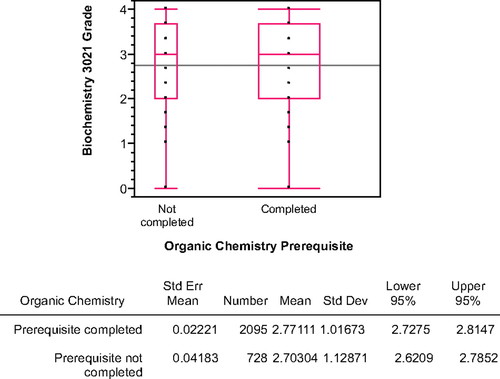
Figure 1. Analysis of Biochemistry 3021 grades relative to completion of the organic chemistry requirement. One-way analysis of variation revealed little difference in the median, mean, quartiles, or grades of students who did or did not complete organic chemistry before Biochemistry 3021. The solid line across the graph represents the grand mean. The data are presented as a box plot in which the top of the box represents the 75th percentile, the bottom of the box represents the 25th percentile, and the line within the box represents the median sample value. The range of values is shown by the lines that extend from each box. No statistically significant differences were found between the two groups (t test, assuming equal variances: t-stat = −1.51; p = 0.1308; ANOVA: F-stat = 2.285).
Based on their average total credits, the students who had not completed the organic chemistry prerequisite were less advanced than those who had completed the prerequisite (Figure 2). Specifically, students without the prerequisite had an average of 64 total credit hours, placing them at the beginning of their junior year. However, students who had completed the prerequisite had an average of 96 credit hours, placing them early in their senior year.
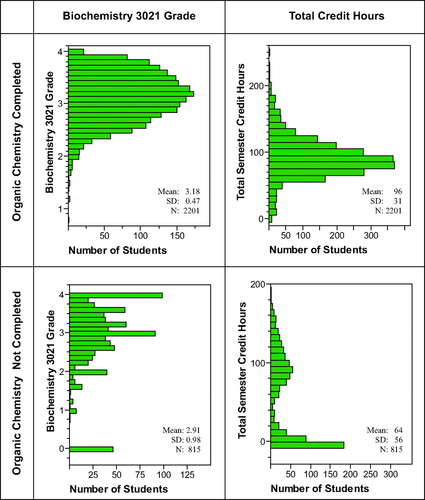
Figure 2. Comparison of average GPA and transfer credits of students in Bioc 3021 relative to completion of the organic chemistry course prerequisite. The Bioc 3021 grade distribution differed significantly between students who had versus who had not completed an organic chemistry course. A larger proportion of both grades “A” and “F” were earned by students without the prerequisite. Students who had not completed the prerequisite also included a larger proportion of students with <30 credits.
Differences between the students with and without the prerequisite were also apparent in the average cumulative GPA of the two populations: those who had not completed the organic chemistry prerequisite had an average GPA of 2.92, whereas those who had completed the organic chemistry prerequisite had an average GPA of 3.18. In addition, no students who had completed the organic chemistry prerequisite had a cumulative GPA of zero, whereas 47 of the 815 students who had not completed the prerequisite had cumulative GPA of zero. All of the students with a zero cumulative GPA had no earned credits at the University of Minnesota and, thus, were new students in their first semester of study at the university who either globally failed, withdrew, or stopped attending all of their classes. If these students are removed from consideration, the average Bioc 3021 grade of students without the organic chemistry prerequisite is 2.817, actually higher than the average of students with the prerequisite. Thus, the decreased average Bioc 3021 grade in students without the organic chemistry prerequisite is due to new students who globally failed in their first semester at the University. In summary, no improvement in performance in Bioc 3021 could be attributed to completion of the organic chemistry prerequisite.
Students Who Had Not Completed the Organic Chemistry Prerequisite Were More Likely to Withdraw from Biochemistry 3021 Than Those Who Completed the Organic Chemistry Prerequisite
Given the lack of prerequisite advantage on the average grade in Biochemistry 3021, we examined the distribution of grades in the two groups of students (Figure 3). Slightly lower failure rates (grades of D+, D, F, and N) were observed in students who completed the prerequisite (8.9%) versus students who did not complete the prerequisite (10.2%). In addition, fewer students without the prerequisite earned A grades and more earned C grades. These differences were relatively small, however, affecting a small proportion of the thousands of students enrolled in Bioc 3021 during the time of our analysis.
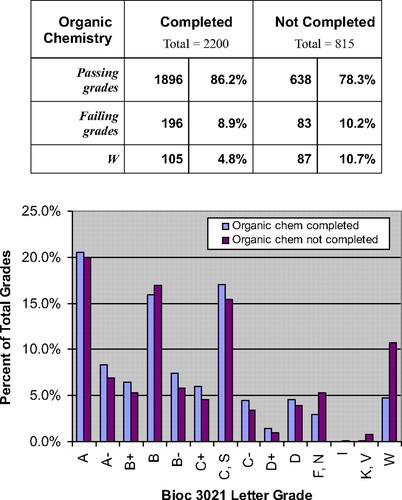
Figure 3. Distribution of letter grades in Bioc 3021 relative to completion of the organic chemistry course prerequisite. Students who had not completed the organic chemistry course prerequisite had a slightly higher proportion of failing grades and a significantly higher proportion of withdrawals.
In contrast to the slight differences in grade distribution between the two populations of students, we observed a large difference in withdrawal rates: 10.7% of students who had not completed the prerequisite withdrew from the course after the second week, whereas only 4.8% of students who had completed the prerequisite did so.
We considered that the high withdrawal rate might reflect a substantially higher number of globally failing students. Of the 87 students with W grades who had not completed organic chemistry, 18 were first-semester, “global failure” students with cumulative GPAs of zero. However, excluding these students from consideration decreases the withdrawal rate only to 8.7%, still nearly twice the withdrawal rate of students who had completed the prerequisite.
In addition, we considered the possibility that students who failed or withdrew from all courses in the semester in which they withdrew from Bioc 3021 might account for many of the withdrawals. Consistent with this hypothesis, about half (47%) of the “semester failure” students withdrew from Bioc 3021. However, when the semester failure students are excluded from analysis, the withdrawal rate of students without organic chemistry was still higher (6.7%) than that of students with organic chemistry (3.8%). Thus, completing organic chemistry decreased the likelihood of withdrawal from Bioc 3021.
Completion of the Organic Chemistry Prerequisite at the University of Minnesota May Have More Value for Transfer Students than for Students Admitted from High School
Our enrollment management software includes data for only those courses that are completed at the University of Minnesota. Thus, in our analysis, students with organic chemistry transfer credit from another institution would be included in the same category as students who had never taken organic chemistry.
To test the possibility that higher levels of performance of transfer students with cryptic organic chemistry credits may be masking differences in overall student performance, we analyzed these two populations of students separately. Based on admission data, nearly all students who are admitted to the University of Minnesota with >60 credits have transferred from another institution, and thus might have taken organic chemistry elsewhere. Similarly, nearly all students with <30 transfer credits are admitted to the University of Minnesota from high school (new high school [NHS] students), and are unlikely to have taken organic chemistry elsewhere. Thus, if transfer students show significantly higher levels of performance in Bioc 3021 than NHS students, the conclusion that the organic chemistry prerequisite has minimal impact would be compromised.
Figure 4 compares the average grades of transfer and NHS students in Bioc 3021. Of the 463 transfer students who took Bioc 3021 in fall 2003 to summer 2006, 205 had actually completed the organic chemistry requirement at the University of Minnesota by the time they enrolled in Bioc 3021. However, 258 had no record of completion of organic chemistry and, thus, may either have completed organic chemistry elsewhere or not yet taken the course. For students admitted from high school (NHS students), 1679 had completed the prerequisite and 489 had not done so.
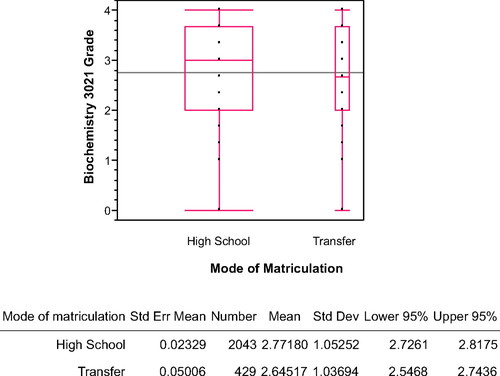
Figure 4. Distribution of Bioc 3021 grades relative to student matriculation. The average Bioc 3021 grade of transfer students was significantly lower than the average of students who entered the college from high school (t test: t-stat = −2.27, df = 2470, p = 0.0222; ANOVA (F-stat = 5.158, df = 2470, p = 0.0232).
Interestingly, the NHS students who had not taken the organic chemistry prerequisite had an average Bioc 3021 grade of 2.80, nearly equivalent to the 2.76 grade of NHS students who had taken the prerequisite. In addition, the NHS students who lacked the organic chemistry prerequisite had an average of only 33 total credits, indicating that they were taking the course much earlier in their academic career (early sophomore year). In fact, 38 of the NHS students were taking Bioc 3021 in their first semester at the University of Minnesota.
In contrast, transfer students who had no record of organic chemistry at the University of Minnesota had a 2.54 average grade in Bioc 3021, whereas those who had taken organic chemistry at the University of Minnesota had an average grade of 2.77. Consequently, the data do not support the possibility that transfer students who have actually completed organic chemistry elsewhere might be positively skewing the data. In fact, as a group, transfer students actually performed less well in Bioc 3021 than NHS students. Thus, even if transfer students had completed organic chemistry before taking Bioc 3021 at the University of Minnesota, it did not positively affect their performance in Bioc 3021.
The unexpectedly strong performance of NHS students who had not completed the organic chemistry prerequisite, together with their low number of total credits, suggests that many of these students may be honors students or others with high academic potential. The overall grade distribution in Bioc 3021 is generally consistent with this possibility (Figure 5 and 6): NHS students who had not completed organic chemistry earned the highest proportion of “A” grades (25.8%) among all of the groups examined. However, the cumulative GPA (2.901) of NHS students who had not completed the organic chemistry prerequisite is not consistent with the possibility that they were, as a group, academically distinguished.
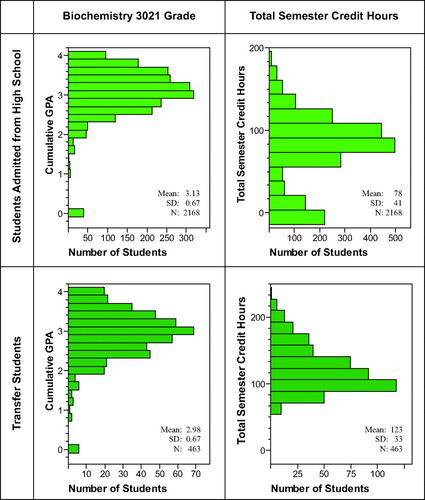
Figure 5. Comparison of average GPA and transfer credits of students in Bioc 3021 relative to matriculation into the university. Similar cumulative GPAs were earned by Bioc 3021 students who entered the University of Minnesota from high school or as transfer students from other institutions. Bioc 3021 students ranked as freshmen or sophomores based on credits had all entered from high school. Thus, among students taking Bioc 3021, the average transfer student taking Bioc 3021 was more advanced than the average student admitted from high school.
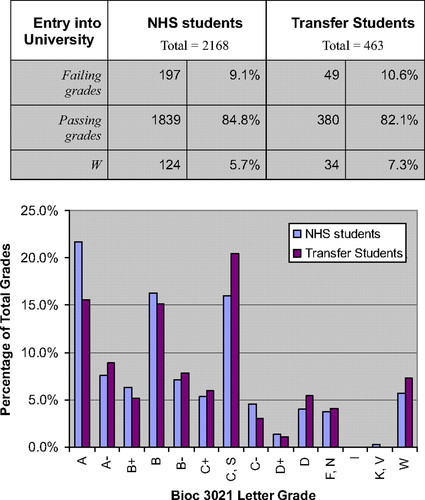
Figure 6. Distribution of letter grades in Bioc 3021 relative to matriculation mode. Overall, transfer students and students admitted from high school had a similar distribution of Bioc 3021 grades, except that transfer students earned fewer “A's” and more “C's” than students admitted from high school.
Biological Sciences Majors Seem to Benefit Most from Completing the Organic Chemistry Prerequisite
We suspected that overall performance of biological sciences majors in Bioc 3021 would be higher than that of students from other colleges. Similarly, because biological sciences majors were likely to have more exposure to biology through high school and their personal interests, we expected that they might benefit the least from completion of the organic chemistry requirement. However, these hypotheses were not supported by the data (Figure 7).
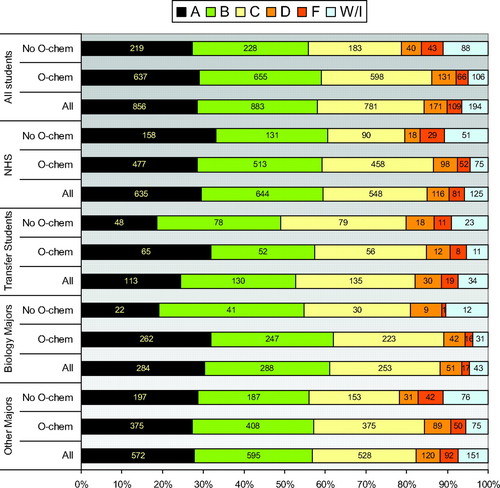
Figure 7. Comparison of Bioc 3021 letter grades among different populations of students.
Completion of the prerequisite had little overall impact on the performance of nonbiological sciences majors. For example, nonbiological sciences majors who had not completed the organic chemistry prerequisite demonstrated similar increases in the number of withdrawals and slight increase in the number of failing grades as seen in the overall student population. In addition, the Bioc 3021 average grade and grade distribution were similar among nonbiological sciences students who completed the prerequisite and those who did not.
In contrast, completion of the organic chemistry prerequisite had significant positive impact on the average grade and the grade distribution of biological science majors. On average, biological sciences majors who completed the prerequisite had an average grade that was 0.18 points higher than those who did not. Only half as many biological sciences majors who lacked the prerequisite earned A grades as biological sciences majors who had completed the prerequisite.
Completion of the Organic Chemistry Requirement Has Limited Overall Value for Predicting Student Success in Bioc 3021
Figure 7 compares the proportion of grades in various populations of students to that of the overall population. From this comparison, several interesting observations can be made. First, students lacking the organic chemistry prerequisite exhibit increased failure and withdrawal rates. However, these failures are offset by the high Bioc 3021 grades in this population, such that only a modest decrease (0.07) is observed between the populations. Second, biological sciences majors have less risk of failure or withdrawal than students enrolled in other colleges. Third, students admitted from high school are more likely to earn an A in Bioc 3021 than transfer students.
However, these correlations were more subtle than we expected. Consequently, we examined the relationship between cumulative GPA and Bioc 3021 grades. Figure 8 shows that there is a strong positive correlation between the cumulative GPA and the Bioc 3021 grade. Other than the similar relationship between average semester grade and the Bioc 3021 grade, this relationship was the only strong correlation, positive or negative, that we uncovered in our pairwise analyses of all factors in this study, including transfer credits, total credits, grade in General Chemistry 1 and 2, organic chemistry lecture, college of enrollment, or major.
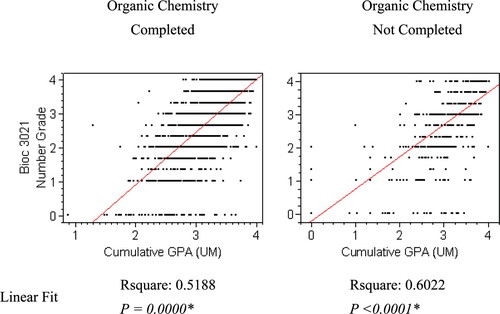
Figure 8. Correlation between Bioc 3021 Grade and cumulative GPA. Students' cumulative GPA on course work at the University of Minnesota was strongly, positively correlated with their grade in Bioc 3021.
To determine the increased student success that enforcing the organic chemistry prerequisite would potentially bring, we analyzed the predictive value that completion of the prerequisite might provide (Table 3). This analysis was based on the assumption that, if completion of the prerequisite were important for student success, no students who had completed the prerequisite would be predicted to withdraw or fail Bioc 3021. Conversely, no students who had not completed the prerequisite would have been predicted to successfully complete Bioc 3021. Based on this analysis, enforcement of the organic chemistry prerequisite would have prevented 171 failures, but it would have also prevented 630 successes (including 219 “A” grades). In addition, enforcement of the organic chemistry prerequisite would have failed to prevent 303 failing grades. Because the enrollment software is blind to transfer course work, enforcing the prerequisite would result in the need to individually register all transfer students into Bioc 3021, after a detailed review of their academic record. The marginal impact on student success associated with enforcing the prerequisite was not judged to be sufficient to offset the substantial increase in effort needed to enroll transfer students in the course. Instead, we concluded that improving student success in the course might focus on providing increased support for students who enroll in Bioc 3021 with overall GPAs that are <2.5.
| Organic chemistry prerequisite | ||
|---|---|---|
| Completed | Not completed | |
| No. of students who succeeded (i.e., earned a grade of C- or higher) | 1890 | 630 (not predicted) |
| Students who failed (i.e., earned grades of D, F, W, or I) | 303 (not predicted) | 171 |
DISCUSSION
Our results showed a surprising disconnect between student performance in introductory biochemistry and their completion of the organic chemistry prerequisite. Thus, our results are inconsistent with organic chemistry being important for either the “content mastery” or “maturity” models of prerequisites described in the Introduction.
Our results contrast markedly with the conclusions of McCoy and Pierce, who examined the role of prerequisites in biology courses at the University of South Florida (McCoy and Pierce, 2004) They compared the overall grade distributions of students enrolled in upper-division biology courses in one academic year with and without the prerequisites. Although they do not reveal which particular courses they examined, they report that students without the prerequisites had only a 53% likelihood of earning a grade of “C” or better in these courses. In addition, enforcing prerequisites decreased the failure rate by 18% and the withdrawal rate by 21%. Consistent with McCoy and Pierce (2004), our data also show an increased rate of withdrawal among students in Bioc 3021 who lacked the organic chemistry prerequisite. However, we found only modest differences in grades between the two populations of students: when withdrawals are excluded, 88.5% of Bioc 3021 students without the prerequisite earned a grade of “C−” or better grade compared with 90.6% of students with the prerequisite; 11.5% of Bioc 3021 students without the prerequisite earned a failing grade compared with 9.4% of students with the prerequisite. It is possible that more fine-grained analysis of the University of South Florida data might result in different conclusions from those presented in their paper. For example, perhaps many of the failing grades occur in a particular class in which a prerequisite course is critical for student success. Similarly, we would probably also find different results if we looked at different courses with different prerequisites.
Consistent with this possibility, Zhang et al. (2004) found that only certain prerequisites are important for success in an engineering program of study. Specifically, they examined the effect of the required core science courses in math, chemistry, and physics on retention of students in engineering programs. The assumption they tested is that high performance in these required basic science courses would have a strong positive impact on retention of students in engineering programs. However, only six of the 20 required courses showed any statistical significance for student retention in engineering; these courses were Chemistry Labs 1 and 2, Chemistry 1 lecture, Calculus 1 and 2, and Physics 1 lab. It is interesting to note that half of the courses that were predictive of success were laboratory courses. In fact, the course with highest significance was General Chemistry Lab 1. Students who earned a grade of “B” in this lab course had a 59% higher probability of retention in the engineering program than students who earned a grade of “C.” In contrast, students who earned a grade of “A” in the Differential Equations course, or the other 13 courses with no predictive value, were no more likely to be retained in the engineering program than those who earned a grade of “C” in the course. Thus, Zhang et al. (2004) suggest that the majority of required basic sciences courses are poor predictors of student success in engineering.
Consistent with Zhang's study, other program-level analyses reach similar conclusions concerning the variable correlation between prerequisites and student success. Woodward and McAuley (1983) compared the performance of medical school interns who had completed all of the traditional prerequisite undergraduate courses (i.e., a 3.1 GPA or higher, and courses in biology, general and organic chemistry, and physics) with interns who were deficient in one of these prerequisites. No difference in the performance of the interns could be detected by their clinical supervisors, suggesting that none of the traditional prerequisites was important for success as a practicing physician. However, other studies have uncovered positive correlations between a particular set of courses and student success in subsequent professional programs. For example, a bachelor's degree and advanced biology course work were positively correlated with performance in and graduation from pharmacy school. (McCall et al., 2006). Given these different results, the available data do not support any global conclusions about the overall value or lack of value of prerequisites. Indeed, it is possible that completion of organic chemistry is important for success in other biochemistry courses at the University of Minnesota or elsewhere.
Similar to our observations, the lack of impact of prerequisites and the positive correlation between overall GPA and the grade in a particular course has been seen in other studies. For example, Brookshire and colleagues found that GPA was the only variable that was positively correlated with grades in a management science course (Brookshire and Palocsay, 2005). These results support the common-sense idea that a student's record of overall academic performance as measured by grades would be relatively consistent. That is, a student who has high average grades in his/her overall course work is more likely to earn a high grade in any particular course than one who has low average grades. This result has important implications for examining the impact of prerequisites. Interestingly, we found that students who chose to disregard the posted prerequisite actually had a lower cumulative GPA (2.92) than those with the prerequisite (3.18). Thus, to evaluate whether or not a specific prerequisite has a positive impact on student success, overall academic ability needs to be taken into account. We could have eliminated all failing grades in Bioc 3021 simply by enforcing a prerequisite GPA of greater than 2.9. However, such a policy would not have eliminated the withdrawals: 46 students with GPAs greater than 2.9 still withdrew, supporting the idea that withdrawals may frequently result from personal problems (time management, health, family, and finances) rather than an inability to complete the course.
The results of our detailed analysis of student performance were not consistent with the expectations of the Bioc 3021 instructors. Their empirical experiences with students led them to presume that most students with academic problems had not completed the prerequisite organic chemistry course. They reasonably extrapolated to the conclusion that most failing students do so because they lack prerequisite knowledge and skills they would gain in organic chemistry. In fact, we suspect that instructors may actually be responsible for the increased withdrawal rate among students who lack the prerequisite, because they may be more likely to advise these struggling students to withdraw than similar students who had completed organic chemistry. At least part of the inconsistency between faculty expectations and the facts concerning the value of organic chemistry may be due to inaccurate assumptions about what students know when they enter our classes. Rovick et al. (1999) examined the accuracy of physiology teachers' understanding of their students' background knowledge and skills. They found that, in general, faculty underestimate the content knowledge that students have and overestimate their students' skills in using that knowledge to solve problems. Thus, the disconnect between our established course prerequisites and the genuine value they have in student performance may reflect our unsophisticated understanding of the learning outcomes that occur in the prerequisite courses. It is also useful to point out that students' awareness of the organic chemistry prerequisite may have served as a deterrent to enrollment for students with weak chemistry backgrounds. Thus, less prepared students may not typically enroll in Bioc 3021 until they have completed the organic chemistry course, even though that requirement is not enforced. However, this possibility, that an unenforced prerequisite results in enrollment of well-prepared students, is also inconsistent with faculty expectations.
Finally, it is also important to point out the obvious: We teach the students who enroll in our courses. Thus, students may be doing well in Bioc 3021 in spite of their lack of preparation because of the skillful teaching of the Bioc 3021 instructors. There is also the insidious possibility that instructors are adapting their course content to accommodate the limited background knowledge of their students. If so, instructors may be accommodating poorly prepared students by teaching a course that is less rigorous or demanding than the ideal. If instructors could be certain that every student enrolled in Bioc 3021 had completed organic chemistry, they might alter their course content, pace, or in other ways raise their expectations.
Regardless of our results and their possible interpretations, it is clear that completion of a prerequisite course does not guarantee that the student actually remembers what he/she learned in that prerequisite class, which might have been taken years earlier. One approach we are testing to resolve this issue is to define what we expect students to know and be able to do when they enter our courses and then, through placement quizzes, hold them accountable for that information. We expect that this “knowledge accountability” or “competency” approach will be more effective than enforced course prerequisites for ensuring that instructors are not constrained by students who are inadequately prepared for their class.
ACKNOWLEDGMENTS
We thank the Biochemistry 3021 instructors, especially Janet Schottel, for her dedication to student learning. Her desire to improve student success in her classes was the impetus for this study. This study was approved by the University of Minnesota Institutional Review Board, study 0807E39301.



